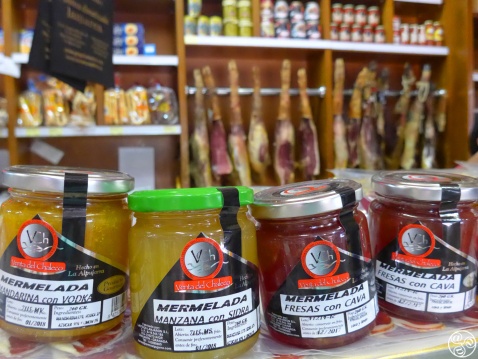
Jams with local fruits and liquors on sale on at a local Deli´s in Almeria |
|
GASTRONOMY
In a few decades, Almeria’s gastronomy has undergone a spectacular transformation. From rather scarce products from the land and sea, it has passed to intensive agricultural production and, finally, to products of extraordinary quality that are exported all over the world.
Half a century ago, the farmers of Almeria began to reuse the wooden and wire structures that held the vineyards of their traditional table grape cultivation to cover them with plastic and protect their new crops from the wind. They realized that their apparently arid lands kept a rich legacy of their turbulent geological past of volcanic origin: very fertile land that only needed water, and that they obtained from the subsoil.
Almeria farmers knew how to combine traditional productions (legumes, nuts, cereals, olive oil) with the fruits and vegetables grown in their innovative greenhouses: crops under shelter to protect them from the wind, most of them between Campo de Dalías and Campo de Níjar, warmed by the sun. And this technique has led to an agri-food revolution that has turned the province of Almeria into the largest European fruit and vegetable producer.
Fish and seafood are one of the main bases of Almerian cuisine. The Mediterranean coast guarantees the freshness of its produce such as red prawns from Garrucha, John Dory, red mullet, pearly razorfish, mackerel, grouper, seabream, horse mackerel, mussel clams, squid, cuttlefish and octopus.
Another gastronomic treasure that Almeria hides is the extra virgin olive oil, specifically, that of an exceptional place due to its climatic conditions for its cultivation: the Tabernas desert, which provides its maximum amount of natural antioxidants. And the pioneering company, Castillo de Tabernas, is the one that has achieved the greatest external projection.
As for Almerian pastries, there is an all-time favourite here kown as, glaseado de meringue (glazed meringues). Other sweets include yemas (custard tars), jam with local fruits cava, millefeuille, and milindros (sponge fingers). At Easter, the borrachillos (liqueur buns) or buñuelos rellenos (stuffed doughnuts) are a must try. As the province is the leading producer of almonds in Andalusia, an exquisite nougat is made here, very traditional in all Spanish households at Christmas.